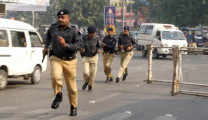500-year-old Pharwala Fort lies in ruins
Fortification wall, gates of once-invincible citadel disappeared from all sides

The 500-year-old Pharwala Fort — once considered to be the most unassailable fort because of its well-protected high ridges and deep ravines — in Kahuta tehsil of Rawalpindi has turned into ruins due to lack of maintenance and upkeep.
The fortification wall and five of the six entrance gates of the fort, a national heritage, have disappeared. The fort spread over 450 acres holds great significance in the history of the subcontinent. Locals also expressed their restlessness about the obliteration of the historical heritage. Tombs in the 16th-century fort's premises have also fallen into disrepair.
The Pharwala Fort, which is located in Kahuta Aliot, just 40 kilometres from Rawalpindi, is a forgotten treasure to the citizens of Rawalpindi and Islamabad.
Historically, the Phirwala Fort was once a part of the Ghakhar empire. Its borders extended from Kallar Kahar, Jhelum, Kallar Syedan to Dudyal Azad Jammu and Kashmir, Rawalpindi to Attock and Hazara up to Kohistan.
The fort was considered to be the defence headquarters with a capacity to house 500 soldiers, 50 elephants and 100 horses. According to tradition, the fort, considered to be the stronghold of the Gakhar clan, was conquered by the Mughal emperor Babur in 1515.
The Himalayan mountain range is situated on one side of the fort and Sawan River on the other side.
Hafeet Ghakhar, a local, said that the maintenance of the fort is a far-fetched matter as no department has constructed a separate road to reach the fort from Aliot and that was the reason that the fort has turned into a ghost house. “Even if tourists wanted to visit the fort, there is no road to reach here except for on foot through difficult mountain paths,” he said adding that the fort has collapsed from inside and outside with fortification walls disappearing.
He said that the traces of the fort are slowly disappearing due to the collapse of protection walls. The compound, where there once used to be warehouses for horses and elephants, has now become the dens of buffaloes and goats.
Several houses spread around the fort have encroached on its premises. Its main gate, which is said to have been used for elephants and horses, exists but the remaining five gates have completely smashed.
Considering the historical importance of the fort, locals said, they have written several letters to the department of archaeology to declare it a national heritage site but they did not get any response. The Pharwala Fort also has vestiges of guard rooms built in the 15th century.
There are also 10 to 15 graves on the premises of the fort which are said to belong to the Sultans of Ghakhas of that time. Several attempts were made to take the point of view of the Punjab Archaeology Department on the dilapidated condition of Pharwala Fort, but no official was forthcoming to give the version.
Published in The Express Tribune, August 26th, 2022.



















COMMENTS
Comments are moderated and generally will be posted if they are on-topic and not abusive.
For more information, please see our Comments FAQ